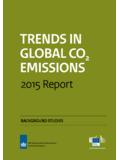Transcription of INSTITUTIONAL CAPACITY AND CLIMATE ACTIONS
1 Organisation for Economic Co-operation and Development 2003 international energy agency Organisation de Coop ration et de D veloppement Economiques Agence internationale de l' nergie COM/ENV/EPOC/IEA/SLT(2003)5 OECD ENVIRONMENT DIRECTORATE international energy agency INSTITUTIONAL CAPACITY AND CLIMATE ACTIONS St phane Willems and Kevin Baumert COM/ENV/EPOC/IEA/SLT(2003)5 2 Copyright OECD, 2003 Application for permission to reproduce or translate all or part of this material should be addressed to the Head of Publications Services, OECD, 2 rue Andr Pascal, 75775 Paris, Cedex 16, France. COM/ENV/EPOC/IEA/SLT(2003)5 3 FOREWORD This document was prepared in November 2003 by the OECD Secretariat at the request of the Annex I Expert Group on the United Nations Framework Convention on CLIMATE Change.
2 The Annex I Expert Group oversees development of analytical papers for the purpose of providing useful and timely input to the CLIMATE change negotiations. These papers may also be useful to national policy makers and other decision-makers. In a collaborative effort, authors work with the Annex I Expert Group to develop these papers. However, the papers do not necessarily represent the views of the OECD or the IEA, nor are they intended to prejudge the views of countries participating in the Annex I Expert Group. Rather, they are Secretariat information papers intended to inform Member countries, as well as the UNFCCC audience. The Annex I Parties or countries referred to in this document refer to those listed in Annex I to the UNFCCC (as amended at the 3rd Conference of the Parties in December 1997): Australia, Austria, Belarus, Belgium, Bulgaria, Canada, Croatia, Czech Republic, Denmark, the European Community, Estonia, Finland, France, Germany, Greece, Hungary, Iceland, Ireland, Italy, Japan, Latvia, Liechtenstein, Lithuania, Luxembourg, Monaco, Netherlands, New Zealand, Norway, Poland, Portugal, Romania, Russian Federation, Slovakia, Slovenia, Spain, Sweden, Switzerland, Turkey, Ukraine, United Kingdom of Great Britain and Northern Ireland, and United States of America.
3 Korea and Mexico, as new OECD member countries, also participate in the Annex I Expert Group. Where this document refers to countries or governments it is also intended to include regional economic organisations , if appropriate. ACKNOWLEDGEMENTS This paper was prepared by St phane Willems, Organisation for Economic Co-operation and Development, and Kevin Baumert, World Resources Institute. The authors thank Jan Corfee-Morlot, Jonathan Pershing, Cedric Philibert, Tom Jones, Jane Ellis, Stephen Bygrave, William Blyth, Harald Winkler, as well as AIXG delegates, for their helpful comments to earlier drafts of this paper. Questions and comments should be sent to: St phane Willems OECD Environment Directorate Global and Structural Policies Division 2 rue Andr Pascal 75775 Paris, France Email: Tel: +33 1 45 24 96 97 Fax: +33 1 45 24 78 76 OECD and IEA information papers for the Annex I Expert Group on the UNFCCC can be downloaded from: COM/ENV/EPOC/IEA/SLT(2003)5 4 TABLE OF CONTENTS EXECUTIVE SUMMARY.
4 5 1. 8 2. ASSESSING CAPACITY FOR CLIMATE ACTIONS .. 10 INSTITUTIONAL CAPACITY : general An evolving concept .. 10 Levels of INSTITUTIONAL CAPACITY .. 11 Capacities and functions .. 15 CAPACITY for CLIMATE ACTIONS .. 17 CLIMATE -specific CAPACITY CLIMATE -relevant CAPACITY needs .. 20 Country-specific CAPACITY 21 3. INSTITUTIONAL CAPACITY AND FUTURE POLICY OPTIONS .. 23 Defining next steps: possible options .. 23 Quantitative approaches to CLIMATE policy .. 24 Kyoto-style national targets .. 24 Dynamic targets .. 28 Targets with Price 32 Non-binding national 34 Sectoral 36 Other approaches .. 37 Policies and measures .. 38 Technology development and co-operation .. 40 4. 42 44 ANNEX SELECTED CRITERIA FOR ASSESSING INSTITUTIONAL 48 COM/ENV/EPOC/IEA/SLT(2003)5 5 Executive Summary This paper explores the concept and substance of country-level INSTITUTIONAL CAPACITY in the context of future CLIMATE -related ACTIONS .
5 The main thrust of the paper is that an INSTITUTIONAL approach, based on CAPACITY assessments, could provide useful insights, both at national and international levels, on the appropriate next steps for CLIMATE ACTIONS . Thus, the paper proposes a generic assessment of INSTITUTIONAL CAPACITY , with the aim to help develop a common understanding across countries of what INSTITUTIONAL CAPACITY actually is and what INSTITUTIONAL CAPACITY would be required for various forms of future ACTIONS . However, the paper fully acknowledges that country-level INSTITUTIONAL CAPACITY assessments are essentially country-specific and need to be undertaken in a national context. Some national case studies have been prepared together with this paper (see OECD, INSTITUTIONAL CAPACITY and CLIMATE ACTIONS , 3 case studies, 2003) to emphasise the country-specific aspect of this debate.
6 To be sure, current capacities are not the only factor in deciding on future policy options. First, governments need not have all the CAPACITY in place before taking steps to combat CLIMATE change. It may well be that, within the next decades, countries will be able to increase their CAPACITY , either through their own means or with assistance from the international community. Second, to some degree, and in some instances, the adoption of a commitment either domestic or international - may act as a driver for CAPACITY building. This was the case for some industrialized and transitioning countries, whose commitments in Kyoto have provided an impetus for the development of the CAPACITY needed to implement and adhere to them. Finally, INSTITUTIONAL CAPACITY needs are only one key consideration when assessing future CLIMATE policy options. Other considerations when evaluating different forms of future ACTIONS include environmental effectiveness, cost-effectiveness, the need to deal with economic and scientific uncertainties, and other domestic policy considerations.
7 However, a pragmatic model for the evolution of CLIMATE ACTIONS might include a step by step approach, whereby countries in each step assess their existing capacities and select future ACTIONS that are consistent with the CAPACITY level it can reasonably reach within a given time frame. While each new step is likely to involve some CAPACITY development, CAPACITY requirements should not be too large at each of these steps. If the gap between existing CAPACITY and CAPACITY that is required is too large for a particular policy option, it could become virtually impossible for a country to abide by what it has committed to do, either domestically or internationally. In this framework, the level of existing capacities in a country is likely to define the kind of next step that the country can take. However, it is also hoped that with each step, CAPACITY will grow, so as to allow for a progressive strengthening of ACTIONS over time.
8 Chapter 2 of this paper discusses the concept of INSTITUTIONAL CAPACITY and analyses the various dimensions of CAPACITY that could be worth exploring when countries assess their own capacities. Chapter 3 analyses INSTITUTIONAL requirements of a number of options for future ACTIONS , thereby giving some initial guidance as to how these options might differ according to their CAPACITY requirements. A coherent view of INSTITUTIONAL CAPACITY In general terms, CAPACITY can be defined as the ability to perform functions, solve problems and set and achieve objectives (Fukuda-Parr & al., 2002). What makes a country able to perform a function, solve a problem or achieve an objective? As already suggested, it is very country-specific, since a country s approach to a particular problem, such as CLIMATE change, is embedded in its complex history, INSTITUTIONAL setting and social fabric. However, it is possible to find some common characteristics of INSTITUTIONAL CAPACITY that are valid across countries.
9 All aspects of INSTITUTIONAL CAPACITY are important for the success of CLIMATE policy COM/ENV/EPOC/IEA/SLT(2003)5 6 CAPACITY is systemic, so, in some sense, all dimensions of INSTITUTIONAL CAPACITY deserve attention. Increasing the level of human resources or strengthening organisations, while it may be necessary, may not be sufficient to increase CAPACITY . The way individuals and organisations interact both in the public sector and within society as a whole may be more relevant to the overall level of CAPACITY . This is particularly true for CLIMATE policy. As a cross-cutting issue, it requires co-operation among a large number of individuals and organisations. CAPACITY is also required in all phases of the policy process: for instance, a strong monitoring, reporting and review system is needed to enhance the effectiveness of the CLIMATE strategy and individual policies and measures over time.
10 Finally, CLIMATE change, as a cross-cutting issue, means that both CLIMATE -specific and CLIMATE -relevant capacities are needed. CLIMATE -specific CAPACITY is a CAPACITY that is specifically devoted to CLIMATE change issues, while CLIMATE -relevant CAPACITY supports the vast number of non- CLIMATE ACTIONS that may help to mitigate or adapt to CLIMATE change. All countries need a minimum level of CLIMATE -specific CAPACITY A sufficient level of CLIMATE -specific CAPACITY is needed to get CLIMATE policy off the ground: sufficient personnel dedicated to CLIMATE issues in the main organisation responsible for CLIMATE , in other relevant agencies/ministries, in key research centres (or consulting firms) and in businesses and non-governmental organisations; CLIMATE change recognition in the structure of organisations; INSTITUTIONAL arrangements to develop a CLIMATE strategy with the co-operation with all relevant agencies and stakeholders; leadership of an institution; awareness among the general public.














